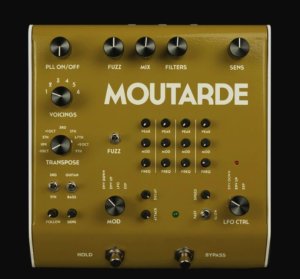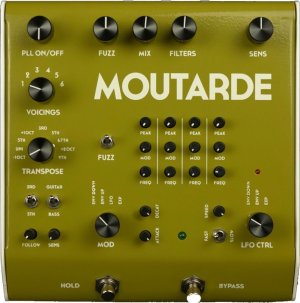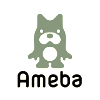GLOU GLOU Moutarde PLL/Filter/Fuzz
FOUR VOICES PLL SYNTH
4 ヴォイス PLL シンセ
・単音からオクターブ/5th/複雑なコード
・個別のコントロールを持つ4つのローパスフィルター
・多彩なモジュレーションやファズ
概要:
・MOUTARDEの中心には、4つのローパスフィルターが並列に動作
・各フィルターは個別に制御
Cutoff (FREQ)/Resonance (PEAK)/Modulation Depth (MOD)
・3つの方法でフィルターをフィード
Dry signal/Gated Fuzz/PLL
・PLLは4つのオーディオ制御スクエア波発振器で構成
2つのロータリースイッチの微調整でオクターブ/5th/シンプル/複雑なコードを調節(VOICINGS)(TRANSPOSE)
・フィルターをドライシグナルとブレンド(MIX)
・フィルタ周波数に適用されるモジュレーションはエンヴェロープ、LFO、またはエクスプレッションペダル(MOD)
・LFOのスピードはエンヴェロープまたはエクスプレッションペダルでコントロール(LFO CTRL)
Octaves, Fifths or complex chords from a single note. Four low-pass filters with separated controls. A bunch of modulations, and a fuzz.
OVERVIEW
At the heart of MOUTARDE, there are 4 low-pass filters running in parallel.
Each filter can be controlled independently. Cutoff (FREQ) , resonance (PEAK) and modulation depth (MOD)
You can feed the filters by 3 ways: dry signal, gated fuzz or PLL
PLL consists of 4 audio-controlled squarewave-oscillators. Octaves, fifths, simple or complex chords can be obtained by tweaking 2 rotary swicthes. (VOICINGS) , (TRANSPOSE)
Filters can be blended with the dry signal. (MIX)
Modulation applied to filters frequency can be either envelope, LFO or expression pedal. (MOD)
The LFO speed can be controlled by envelope or expression pedal. (LFO CTRL)
FILTERS
As mentioned before, there are 4 resonant parallel low-pass filters.
They were specifically designed not to oscillate at highest frequencies, so as to prevent any possible damage to your ears or speakers.
Each filter has its own individual control (mini-knobs) :
Frequency cutoff: FREQ The frequency range of the filters goes from
sub-bass up to mid-treble.
Modulation depth: MOD
Resonance: PEAK
Fully CW the filters are oscillating
FILTERS knob controlls the global level of the filters, it’s useful if you want to tame things in some situations.
MIX knob is used to blend the dry signal with the filtered signal. Fully CCW is dry only and fully CW is filters only.
MOD
This rotary switch selects which modulation is applied to filters: envelope down, envelope up, LFO, expression pedal
In addition, it shifts the frequency range of each FREQ knob up or down.
envelope down = higher frequencies.
envelope up = lower frequencies.
LFO or expression pedal = mid frequencies.
ENVELOPE
SENS sets the sensitivity of the envelope generator.
Settings will vary according to your playing dynamics, your instrument (guitar/bass) or pickups (single coil/humbucker).
This envelope generator is followed by a slew limiter that will slow/smooth the envelope:
ATTACK slows down the attacks
DECAY slows down the decay
When increasing ATTACK, you may need to increase SENS
LFO
This is a simple triangle LFO with two frequency ranges: SLOW and FAST.
LFO frequency is set by the small SPEED knob. The corresponding LED will blink according to the speed.
BONUS FEATURE: when the switch is on FAST position, LFO will be acting on other modulations (envelope down, envelope up, expression pedal).
EG: if MOD selector is on envelope up and LFO switch is on FAST, the resulting modulation will be an envelope modulated by a LFO. (can be better heard with slower envelopes)
LFO CTRL
With this rotary switch, the LFO rate can be controlled by: (from left to right) none, envelope down, envelope up, expression pedal
In this case, the SPEED knob will set the slowest rate. (don’t put it fully CW, you wouldn’t notice any speed modulation)
FUZZ
It’s a basic PNP transistor gated fuzz.
It’s placed just before the filters input, switching it on has no affect on SENS or on the dry sound.
FUZZ switch turns it on or bypasses it.
FUZZ knob changes the fuzz texture from soft saturation (fully CCW) to hard squared fuzz (fully CW).
The gate starts to engage around 12 o’clock. You’ll be able to hear the noise floor disappearing.
EXPRESSION PEDAL/CV
You can control the filters frequencies or LFO rate with external hardware.
If using a classic/passive expression pedal, use a TRS stereo jack.
If you use CV signal (0-5V), then use a TRS stereo jack with RING detached. (it would temporarily work with a mono jack, but for some reason it’s better to use the cable described above)
PLL
PLL (Phase Locked Loop) is a technology allowing the control of a VCO (Voltage Controlled Oscillator) by an audio source.
The PLL will only work properly when playing single notes, avoid playing chords unless you want to hear sonic chaos.
For best tracking with guitar and bass, please use your neck pickup at full volume. Turning CCW your guitar/ bass tone knob and playing above the 7th fret might be helpful too.
SENS mini-knob determines the sensitivity of the PLL. Fully CW will give the longest sustain. 9 o’clock is a good setting for guitar while 12 o’clock will be better on bass.
FOLLOW mini-knob determines how fast the PLL is following the changes of the input signal. Fully CW, you’ll obtain strange oscillations. Fully CCW, the attack of the PLL is slowed down. Best setting is 9 o’clock if GUITAR/BASS switch is set on guitar and 12 o’clock if set on bass.
GUITAR/BASS switch is about the range of the VCOs, which is limited. Set it on guitar if you play guitar (obviously) or any instruments in the medium-high range. Set it on bass if you need to play in a low range (then you might hit a limit on higher notes).
The PLL section creates 4 squarewave VCOs with different notes.
VCO1 is your root note, that means the exact note you’re playing. It is routed to the first filter (from the left).
VCO2 will be either an octave and a 3rd or 5th down of your root note, depending onthe 3RD/5TH switch setting, and goes into the 2nd filter
VCO3 and VCO4 can carry different intervals depending on the VOICINGS rotary switch (see PLL Tables), and are routed to the 3rd and 4th filter.
Finally, when playing single note melodies, you will obtain chords moving in parallel.
PLL ON/OFF does what it should. Fuzz should be desactivated while in PLL mode. If activated, this will result in bad attack and longer sustain.
TRANSPOSE rotary switch shifts VCO2, VCO3 and VCO4 of the indicated interval (see PLL Tables). VCO1 stays unchanged.
GUITAR/BASS switch also shifts VCO2, VCO3 and VCO4 an octave up when on bass position.
HOLD footswitch is used to momentary freeze VCO2, VCO3 and VCO4.
This function is not working perfectly as you’ll have more or less detune depending on other settings. Best tuning will be obtained with GUITAR/BASS switch set on bass, and TRANSPOSE rotary switch set on 6th, 7th, 8th or 9th position.
SPECIFICATIONS
Power Supply (not included): DC 9V 100mA center negative
Size: 19x18x5 cm Weight: 0,9Kg
Relay true bypass CV in: 0-5V
Glou-Glou "Moutarde" Voicings and Transpose Vol 1
Glou-Glou "Moutarde" Voicings and Transpose Vol 2
Glou-Glou "Moutarde" Brice Delage Session
Glou-Glou "Moutarde" PLL on Bass
Glou-Glou "Moutarde" PLL on Guitar
4 ヴォイス PLL シンセ
・単音からオクターブ/5th/複雑なコード
・個別のコントロールを持つ4つのローパスフィルター
・多彩なモジュレーションやファズ
概要:
・MOUTARDEの中心には、4つのローパスフィルターが並列に動作
・各フィルターは個別に制御
Cutoff (FREQ)/Resonance (PEAK)/Modulation Depth (MOD)
・3つの方法でフィルターをフィード
Dry signal/Gated Fuzz/PLL
・PLLは4つのオーディオ制御スクエア波発振器で構成
2つのロータリースイッチの微調整でオクターブ/5th/シンプル/複雑なコードを調節(VOICINGS)(TRANSPOSE)
・フィルターをドライシグナルとブレンド(MIX)
・フィルタ周波数に適用されるモジュレーションはエンヴェロープ、LFO、またはエクスプレッションペダル(MOD)
・LFOのスピードはエンヴェロープまたはエクスプレッションペダルでコントロール(LFO CTRL)
Octaves, Fifths or complex chords from a single note. Four low-pass filters with separated controls. A bunch of modulations, and a fuzz.
OVERVIEW
At the heart of MOUTARDE, there are 4 low-pass filters running in parallel.
Each filter can be controlled independently. Cutoff (FREQ) , resonance (PEAK) and modulation depth (MOD)
You can feed the filters by 3 ways: dry signal, gated fuzz or PLL
PLL consists of 4 audio-controlled squarewave-oscillators. Octaves, fifths, simple or complex chords can be obtained by tweaking 2 rotary swicthes. (VOICINGS) , (TRANSPOSE)
Filters can be blended with the dry signal. (MIX)
Modulation applied to filters frequency can be either envelope, LFO or expression pedal. (MOD)
The LFO speed can be controlled by envelope or expression pedal. (LFO CTRL)
FILTERS
As mentioned before, there are 4 resonant parallel low-pass filters.
They were specifically designed not to oscillate at highest frequencies, so as to prevent any possible damage to your ears or speakers.
Each filter has its own individual control (mini-knobs) :
Frequency cutoff: FREQ The frequency range of the filters goes from
sub-bass up to mid-treble.
Modulation depth: MOD
Resonance: PEAK
Fully CW the filters are oscillating
FILTERS knob controlls the global level of the filters, it’s useful if you want to tame things in some situations.
MIX knob is used to blend the dry signal with the filtered signal. Fully CCW is dry only and fully CW is filters only.
MOD
This rotary switch selects which modulation is applied to filters: envelope down, envelope up, LFO, expression pedal
In addition, it shifts the frequency range of each FREQ knob up or down.
envelope down = higher frequencies.
envelope up = lower frequencies.
LFO or expression pedal = mid frequencies.
ENVELOPE
SENS sets the sensitivity of the envelope generator.
Settings will vary according to your playing dynamics, your instrument (guitar/bass) or pickups (single coil/humbucker).
This envelope generator is followed by a slew limiter that will slow/smooth the envelope:
ATTACK slows down the attacks
DECAY slows down the decay
When increasing ATTACK, you may need to increase SENS
LFO
This is a simple triangle LFO with two frequency ranges: SLOW and FAST.
LFO frequency is set by the small SPEED knob. The corresponding LED will blink according to the speed.
BONUS FEATURE: when the switch is on FAST position, LFO will be acting on other modulations (envelope down, envelope up, expression pedal).
EG: if MOD selector is on envelope up and LFO switch is on FAST, the resulting modulation will be an envelope modulated by a LFO. (can be better heard with slower envelopes)
LFO CTRL
With this rotary switch, the LFO rate can be controlled by: (from left to right) none, envelope down, envelope up, expression pedal
In this case, the SPEED knob will set the slowest rate. (don’t put it fully CW, you wouldn’t notice any speed modulation)
FUZZ
It’s a basic PNP transistor gated fuzz.
It’s placed just before the filters input, switching it on has no affect on SENS or on the dry sound.
FUZZ switch turns it on or bypasses it.
FUZZ knob changes the fuzz texture from soft saturation (fully CCW) to hard squared fuzz (fully CW).
The gate starts to engage around 12 o’clock. You’ll be able to hear the noise floor disappearing.
EXPRESSION PEDAL/CV
You can control the filters frequencies or LFO rate with external hardware.
If using a classic/passive expression pedal, use a TRS stereo jack.
If you use CV signal (0-5V), then use a TRS stereo jack with RING detached. (it would temporarily work with a mono jack, but for some reason it’s better to use the cable described above)
PLL
PLL (Phase Locked Loop) is a technology allowing the control of a VCO (Voltage Controlled Oscillator) by an audio source.
The PLL will only work properly when playing single notes, avoid playing chords unless you want to hear sonic chaos.
For best tracking with guitar and bass, please use your neck pickup at full volume. Turning CCW your guitar/ bass tone knob and playing above the 7th fret might be helpful too.
SENS mini-knob determines the sensitivity of the PLL. Fully CW will give the longest sustain. 9 o’clock is a good setting for guitar while 12 o’clock will be better on bass.
FOLLOW mini-knob determines how fast the PLL is following the changes of the input signal. Fully CW, you’ll obtain strange oscillations. Fully CCW, the attack of the PLL is slowed down. Best setting is 9 o’clock if GUITAR/BASS switch is set on guitar and 12 o’clock if set on bass.
GUITAR/BASS switch is about the range of the VCOs, which is limited. Set it on guitar if you play guitar (obviously) or any instruments in the medium-high range. Set it on bass if you need to play in a low range (then you might hit a limit on higher notes).
The PLL section creates 4 squarewave VCOs with different notes.
VCO1 is your root note, that means the exact note you’re playing. It is routed to the first filter (from the left).
VCO2 will be either an octave and a 3rd or 5th down of your root note, depending onthe 3RD/5TH switch setting, and goes into the 2nd filter
VCO3 and VCO4 can carry different intervals depending on the VOICINGS rotary switch (see PLL Tables), and are routed to the 3rd and 4th filter.
Finally, when playing single note melodies, you will obtain chords moving in parallel.
PLL ON/OFF does what it should. Fuzz should be desactivated while in PLL mode. If activated, this will result in bad attack and longer sustain.
TRANSPOSE rotary switch shifts VCO2, VCO3 and VCO4 of the indicated interval (see PLL Tables). VCO1 stays unchanged.
GUITAR/BASS switch also shifts VCO2, VCO3 and VCO4 an octave up when on bass position.
HOLD footswitch is used to momentary freeze VCO2, VCO3 and VCO4.
This function is not working perfectly as you’ll have more or less detune depending on other settings. Best tuning will be obtained with GUITAR/BASS switch set on bass, and TRANSPOSE rotary switch set on 6th, 7th, 8th or 9th position.
SPECIFICATIONS
Power Supply (not included): DC 9V 100mA center negative
Size: 19x18x5 cm Weight: 0,9Kg
Relay true bypass CV in: 0-5V
Glou-Glou "Moutarde" Voicings and Transpose Vol 1
Glou-Glou "Moutarde" Voicings and Transpose Vol 2
Glou-Glou "Moutarde" Brice Delage Session
Glou-Glou "Moutarde" PLL on Bass
Glou-Glou "Moutarde" PLL on Guitar









